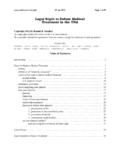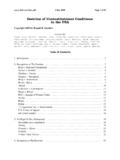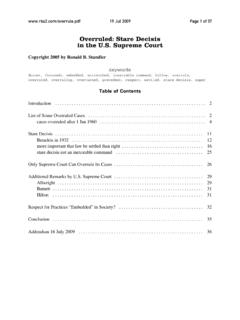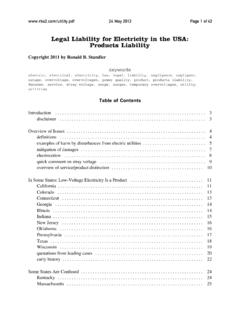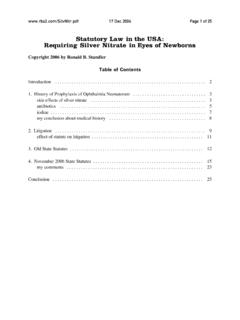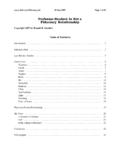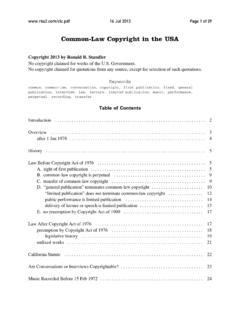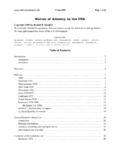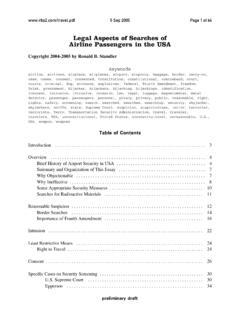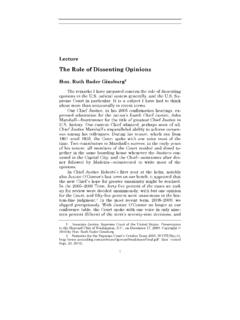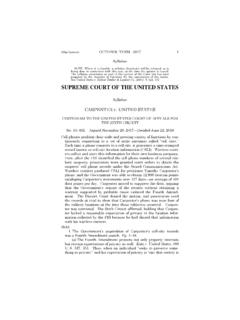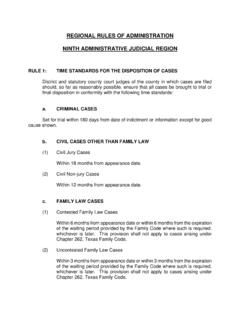Transcription of Copyright Protection for Nonfiction or …
1 Apr 2013 Page 1 of 98 Copyright Protection for Nonfictionor Compilations of Facts in the USAC opyright 2009, 2013 by Ronald B. StandlerNo Copyright claimed for works of the Copyright claimed for quotations from any source, except for selection of such , compilations, Copyright , copyrights, copyrightability, effort, expense,facts, Feist, high-authorship, labor, laborious collection, low-authorship,misappropriation, Nonfiction , skill, sweat of the brow , unfair competition, works,works, Feist Publications v. Rural Telephone, Jeweler's Circular, ToksvigTable of ContentsIntroduction .. 3 Overview .. 4 Feist .. Supreme Court.
2 10applying law to facts of Feist .. 11general remarks in Feist .. 12 Key Publications v. Chinatown Today .. 14commentators .. 15my opinion .. 161. thin Copyright .. 162. ended Protection for author s labor .. 173. constitutional basis .. 174. bigger issues than telephone directories .. 185. maps .. 186. mathematical tables .. 19 Copyright Does Not Protect Facts .. 20A. Constitution .. 21tangential remarks on purpose of Copyright .. 22B. statute .. 22C. judicial opinions .. Supreme Court .. 23 Early Cases (1913-1960) .. 26 Greenbie v.
3 Noble (1957) .. Courts of Appeals (1980-present) .. Apr 2013 Page 2 of 98 Hoehling (1980) .. 31 Iowa State Univ. (1980) .. 33 Miller (1981) .. 33 Harper & Row (1983) .. 34 Eckes (1984) .. 34 Financial Information (1986) .. 36 Worth (1987) .. 36 Sega v. Accolade (1992) .. 37 Sparaco (2002) .. 37NY Mercantile Exch. (2007) .. 39other Courts of Appeals cases .. 40D. commentators on Protection for facts .. 40why some facts should be protected by Copyright .. 42denigration of facts/ideas .. 45 Copyright Protects Labor ? .. 46cases after Feist .. 51 Toksvig.
4 53criticism of Toksvig .. 54labor irrelevant to Copyright .. 59morality .. 60 Recognition of Unfair Competition .. 62 Cases Before 1918 .. 62 International News Service .. 64 Jeweler s Circular and progeny .. 67 Feist ends Protection for sweat of the brow .. 69opinion of the Copyright Office .. 73 Modern State Law of Unfair Competition .. 73 California .. 73 New York .. 74 Texas .. 75 Preemption by Copyright .. 76 Independent Creation Is Neither Infringement Nor Unfair .. 79 Novelty Not Required .. 82 Copyright for Photographs .. 84history of copyrighting photographs.
5 84photograph of public-domain artistic work .. Apr 2013 Page 3 of 98copy of copyrighted work .. 87skill, merit, quality not relevant to Copyright .. 87 Valuation of Writing .. 89 Reviving Unfair Competition .. 90fair use can help protect research .. 93pagination not copyrightable .. 94 Conclusion .. 94 Bibliography .. 96 IntroductionIn 1991, the Supreme Court in Feist either killed or seriously maimed copyrightprotection for compilations ( , collections) of facts. This result is serious problem for: authors and publishers of maps, authors and publishers of books in mathematics, science, and engineering, authors and publishers of Nonfiction history books, proprietary publishers of judicial opinions or statutes, and authors and webmasters of all online authors of such compilations of facts expend labor and money to not only collect facts, butalso to check those facts.
6 Currently, it is uncertain how much legal Protection an author has inpreventing copying of facts that the author collected and checked. As our economy evolves fromsales of manufactured goods to sales of information, law will need to develop new protections forcollections for facts in online databases. Ironically, suitable new protections were developedbefore the year 1923, but were discarded in 1991 by the justices of the Supreme Court inFeist. disclaimerThis essay contains a critical review of the judicial opinion in Feist and its subsequent effecton Copyright owners, authors, and publishers. In particular, I caution the reader that I challengesome accepted dogma in Copyright law, and I advocate some unconventional views that are notaccepted in mainstream Copyright law in the USA.
7 This is a provocative essay that advocateschanges in the law, and is not legal advice on which readers should rely. This essay presentsgeneral information about an interesting topic in law, but is not legal advice for your specificproblem. See my disclaimer at . Apr 2013 Page 4 of 98 I list the cases in chronological order in this essay, so the reader can easily follow the historicaldevelopment of a national phenomenon. If I were writing a legal brief, then I would use theconventional citation order given in the Bluebook. Because part of the audience for this essay isnonlawyers, I have included longer quotations from court cases than typical writing for attorneys.
8 OverviewSince the early 1800s, judicial opinions in the USA have repeatedly said that copyrightprotects labor of authors. Below, beginning at page 46, I argue that Copyright rewards theintellectual labor that is necessary for producing an original work of authorship. By the late1800s, it was already well established that both Copyright law and the evolving common law tortof unfair competition protected the author s investment of labor, skill, and expense a trilogythat is repeated in most of the unfair competition cases after the 1991, copying of a copyrighted compilation of facts was a civil wrong, under either(1) Copyright infringement or (2) the tort of unfair competition for misappropriation of the labor,skill, or expense of a business competitor.
9 The conventional wisdom is that this tort of unfaircompetition was established by the Supreme Court in International News Service Press, 248 215, 236 (1918) and extended by the Second Circuit in Jeweler sCircular Publishing Co. v. Keystone Publishing Co., 281 F. 83, 88 (2d Cir. 1922). WhileJeweler s Circular was the first case to use the phrase industrious collection of facts, it was notthe first case to sanction a business competitor who copied a compilation of facts. Below,beginning at page 62, I trace the history of the tort of unfair competition for misappropriation, andshow that such cases first began in the industrious collection cases were overruled by Feist Publications, Inc.
10 V. RuralTelephone Service Co., Inc., 499 340 (1991). Below, beginning at page 8, I review the Feistcase and then explain why in my opinion Feist is a gross error. For businesses and authorswho are aware of Feist, the rules of law in that case will discourage creation of new compilationsof facts. The rules of law in Feist may allow competitors to unfairly copy an author s laboriousfactual compilation. In a landmark article published in 1981, Prof. Denicola wroteCopyright law has always dealt more comfortably with the novelist, painter, orcomposer, than with the historian, reporter, or compiler. Indeed the very vocabulary ofcopyright is ill suited to analyzing property rights in works of.
